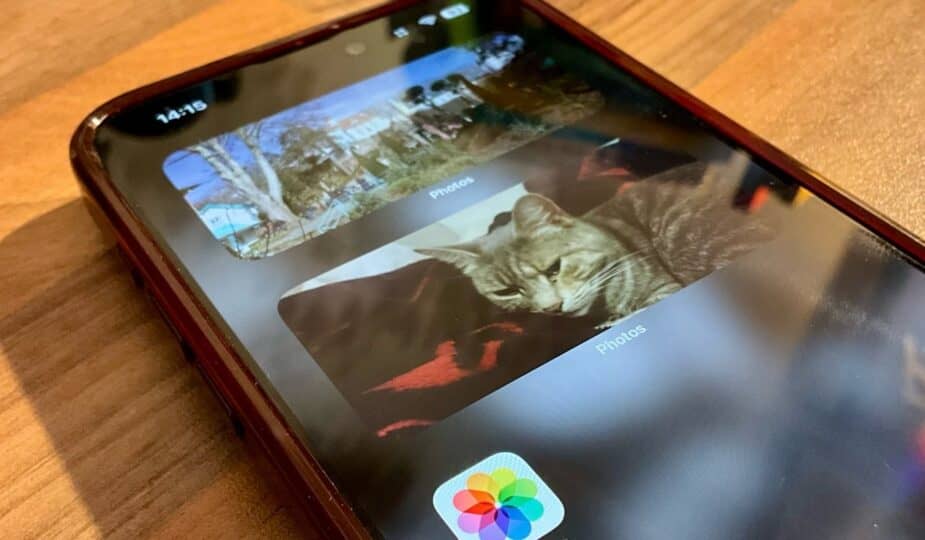Photos widgets in iOS 18.2
 0 Facebook x.com Reddit
0 Facebook x.com Reddit
The TikTok trend makes the startling claim that the iOS photos widget displays who is reading your messages and possibly viewing your photos, and it has no basis in reality at all.
Social media users often post about Apple products and features to educate followers or warn them of potential problems. Sometimes these are simply false claims.
One of the newer trends is accusing Apple of spying on users in ways that make no sense for various reasons. Apparently, this is done through the Photos widget in iOS.
An example of this kind of video comes from TikTok user “Saturnasafather,” aka Nate Michael Limn, who claims in a hard-to-hear 15-second clip that Apple is “snitching” on who looks at your photos or reads your text messages. The clip goes on to explain that the Photos widget can show an image of that person.
@saturnasafather original audio – nate michael limn
This is obviously incredibly wrong.
How the Photos widget works — and how it doesn't
The Photos widget displays images from a user's Photos library in one of two ways. You can set it to show images collected together in Memories and Featured photos, or you can specify a specific album as the source of the images.
Memories and Featured Photos can be considered somewhat random, as the Photos app can automatically generate Memories for the user. Memories can be collections of images that are themed, such as scenes from a day or an event.
Since the user does not necessarily request the creation of some Memories, as they can be generated by the system, this can be perceived as “random”. In turn, it can potentially display a face as the cover for a Memory and therefore display it in the widget.
There are no external forces that create Memories or cause the Photos widget to display a specific person's face.
Everything is still private
The problem with this statement is that it relies heavily on Apple to destroy all goodwill when it comes to privacy. Apple has been saying for years that privacy is a human right, and it works with that notion.
This takes the form of using encryption in many areas, doing on-device processing, and doing everything possible to avoid coming into contact with the user's data at all. When it does need the user's data, it does so by taking as little information as possible and further anonymizing and protecting it.
This is taken to the level where Apple is effectively unable to compromise its own security, even in situations where it could be considered very useful. For example, US security agencies like the FBI have repeatedly asked Apple to unlock iPhones collected from suspects, but while Apple has done everything it could, it simply has not been able to do what was asked.
Then there are the practical elements to consider when considering how such a system would work in the first place. How would it supposedly detect that someone was reading your text messages from an Android device?
Outside of a tightly controlled app platform where it could easily access the data, this is implausible.
Also, consider whether there is any point in Apple “snitching” on its users. If Apple could detect when others were reading your messages, there would be no reason for the company to tell you about it, other than read receipts.
If there was a reason, you'd expect it to be presented as a more formal notification, rather than hidden through the Photos widget.
Given that the company cannot freely provide the FBI with data to solve a murder case, and its work to strengthen and entrench user privacy in its products and services, Apple has no reason to do so.
Me, Myself, and the iPhone
This statement, if you think about it for more than a few seconds, seems pretty stupid. However, that doesn’t stop it from spreading across social media.
It has been observed time and again that social media influencers use the platforms to spread hot takes on whatever topics they want. Often, they share things they’ve heard from other sources, and they make no attempt to provide evidence or apply any scientific rigor to it.
For the author of a post, the main thing is to get more views, and that means creating a lot of content. The more content that is created, the more likely one post is to become a massive success.
Successful posts can mean more followers and better chances of making money.
We've seen this before in bigger waves, like the whole iOS 18 “cheat update” thing because people could hide apps on their iPhones. It was an outrageous claim that users easily picked up and repurposed in their own posts about the topic.
Due to the nature of social media and the need for content to be seen, this problem isn't going to go away because it works.
In Lemon's case, the Photos widget video has garnered over 1.3 million views, making it his most popular video on TikTok. That could be hundreds of dollars or more, according to some platforms' monetization schemes.
That means a fix to stop this behavior will have to come from users. But asking users to do their own research and use more authoritative sources is a tough ask.
After all, the next swipe could be a lot more interesting. Even if it's not true.
Follow AppleInsider on Google News










